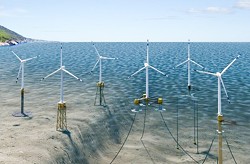[{
"name": "Newsletter Promo",
"id": "NewsletterPromo",
"class": "inlineCenter",
"insertPoint": "4",
"component": "15264767",
"requiredCountToDisplay": "0"
},{
"name": "Ad - Medium Rectangle CC01 - 300x250",
"id": "AdMediumRectangleCC01300x250",
"class": "inlineCenter",
"insertPoint": "8",
"component": "2963441",
"requiredCountToDisplay": "12"
},{
"name": "Ad - Medium Rectangle LC01 - 300x250",
"id": "AdMediumRectangleCC01300x250",
"class": "inlineCenter",
"insertPoint": "18",
"component": "2963441",
"requiredCountToDisplay": "22"
},{
"name": "Ad - Medium Rectangle LC09 - 300x250",
"id": "AdMediumRectangleLC09300x250",
"class": "inlineCenter",
"insertPoint": "28",
"component": "3252660",
"requiredCountToDisplay": "32"
}]
It could take 12 to 15 years to fully develop the planned wind projects off the coast of Morro Bay, according to the Bureau of Ocean Energy Management (BOEM).
"This will be a phased approach with four phases and each phase can last between one and five years," BOEM Renewable Energy Specialist Matthew Blazek said during a Feb. 6 scoping meeting on the project. "It's a long process for a potential wind farm."
BOEM presented the project's environmental impact statement during the online meeting and received public comment from residents, stakeholders, organizations, federal agencies, and tribal, state, and local governments.
Yelena Norwak, the executive director for the Oregon Trail Commission, asked BOEM why it's so hard for community members to submit an alternative wind energy area map.
"This effort is actually productive and constructive. It achieves not only the objective to streamline the offshore wind energy development, but also to protect the environment," she said.
In May 2022, the U.S. Department of Interior auctioned off the first California wind energy leasing areas off the coast of Humboldt and Morro Bay. The two areas were divided into five lease areas and auctioned off for a total of $757.1 million according to an Aug. 22, 2023, Morro Bay staff report. The wind energy areas are located roughly 20 miles offshore.
The project is expected to take between 12 and 15 years to complete, according to BOEM.
According to BOEM's environmental impact statement, offshore wind energy could impact air quality, animals, wetlands, coastal habitats, and commercial and recreational fishing.
"Project structures above the water could affect the visual character defining historic properties, properties of traditional religious and cultural significance, and recreational and tourism areas," the study states. "Additionally, the project could create space-use conflicts with military activities, air traffic, land-based radar services, cables, and scientific surveys."
Groups such as Save the Whales in Salinas argue that wind farm projects bring a lot more harm to the environment than reported by BOEM. It claims that the structures themselves will harm whales and their dependence on sonar.
"Many forms of aquatic marine life have evolved to be highly dependent on sound because vision underwater is only useful for perceiving very short distances. Many forms of aquatic ocean life are only able to understand, perceive, or 'image' their environment using sound," Save the Whales' website states.
BOEM and the National Oceanic and Atmospheric Association's fisheries division have focused on whether sounds expected to be generated by offshore wind activity would be loud enough to cause permanent hearing losses, Save the Whales asserts.
"The scope is so narrow that it will not be able to capture the environmental effects of this project that are reasonably likely to occur," the group states.
John Romero, public affairs officer for BOEM, told New Times that sonar surveys haven't started yet for the Morro Bay wind farm project.
"Currently there are no survey activities occurring on the three federal offshore wind leases off San Luis Obispo County," he said. "Companies have been meeting with local tribes and agencies, like the California Coastal Commission, to outline the various types of surveys and equipment that could be used to obtain information on their respective leases."
Joseph Street, senior environmental scientist for the California Coastal Commission, told New Times that low-energy sonar is used routinely in oceanographic research and fishing, and available data indicates it has few environmental impacts.
"But low-energy sonar surveys occurring on a large scale could have some potential to disrupt marine mammals and sea turtles if appropriate precautions aren't taken, so federal and state agencies—including the Coastal Commission—are requiring protection measures like the use of marine mammal monitors and safe-shutdown zones, to avoid and minimize impacts to marine life," he said. Δ
Latest in News
Comments
Showing 1-1 of 1
Readers also liked…
-

Coast Unified teachers upset over new position's salary and qualifications
Oct 20, 2022 -

SLO police identify alleged driver who hit and killed couple
Dec 22, 2022 -

When the levee breaks: Oceano residents, county officials walk a tightrope of regulations to manage Arroyo Grande Creek, which some say led to the levee's failure in January
May 18, 2023










